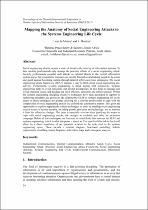 ResearchSpace
ResearchSpace
The readiness of systems engineering at a South African engineering organisation
JavaScript is disabled for your browser. Some features of this site may not work without it.
- ResearchSpace
- →
- Research Publications/Outputs
- →
- Conference Publications
- →
- View Item
| dc.contributor.author |
Malik, HH

|
|
| dc.contributor.author |
Erasmus, Louwrence D

|
|
| dc.contributor.author |
Pretorius, J-HC

|
|
| dc.date.accessioned | 2017-06-07T07:03:40Z | |
| dc.date.available | 2017-06-07T07:03:40Z | |
| dc.date.issued | 2016-09 | |
| dc.identifier.citation | Malik, H.H., Erasmus, L. and Pretorius, J-H. C. 2016. The readiness of systems engineering at a South African engineering organisation. 12th INCOSE SA Conference (2016): Exploring Opportunities, Nurturing Possibilities, 12-14 September 2016, CSIR ICC Pretoria, p. 243-254 | en_US |
| dc.identifier.isbn | 978-0-620-72719-8 | |
| dc.identifier.uri | https://www.incose.org.za/pubs/2016/ | |
| dc.identifier.uri | http://hdl.handle.net/10204/9136 | |
| dc.description | Copyright © 2016 by HH. Malik, Dr L. Erasmus, Prof. JHC Pretorius. Published and used by INCOSE with permission | en_US |
| dc.description.abstract | The purpose of this study is to explore and gain a broad perspective on the systems engineering methods currently employed at a South African research council. The aim is to question if these methods are ideal by comparing them with their alternatives. This paper focuses on the systems engineering methods used within the various competency areas of one of the engineering business units. The suitability of these methods for the nature of work being done in the respective competency areas is also explored. Systems Engineering Management Base Theory (SEMBASE) is used as a framework to find the gaps in each competency area and conclude possible ways of improvement thereof. A qualitative research method is used for this study. The data and information received from the interviews are analysed for emerging patterns that will confirm the theory. The findings show that the competency area focusing on Systems Engineering and Enterprise Architecture is adequately aware of the systems engineering processes and is well-equipped with its tools. The research also reveals that the Technical Competency Areas are not always aware of all the systems engineering processes and lack certain systems engineering tools. Some competency areas are indirectly using Systems Engineering but are unaware of it. More training and awareness is required to fill these gaps amongst the Technical Competency Areas. | en_US |
| dc.language.iso | en | en_US |
| dc.publisher | INCOSE South Africa Chapter | en_US |
| dc.relation.ispartofseries | Worklist;18337 | |
| dc.subject | Systems engineering | en_US |
| dc.subject | Systems engineering methods | en_US |
| dc.subject | Systems engineering management base theory | en_US |
| dc.subject | SEMBASE | en_US |
| dc.title | The readiness of systems engineering at a South African engineering organisation | en_US |
| dc.type | Conference Presentation | en_US |
| dc.identifier.apacitation | Malik, H., Erasmus, L. D., & Pretorius, J. (2016). The readiness of systems engineering at a South African engineering organisation. INCOSE South Africa Chapter. http://hdl.handle.net/10204/9136 | en_ZA |
| dc.identifier.chicagocitation | Malik, HH, Louwrence D Erasmus, and J-HC Pretorius. "The readiness of systems engineering at a South African engineering organisation." (2016): http://hdl.handle.net/10204/9136 | en_ZA |
| dc.identifier.vancouvercitation | Malik H, Erasmus LD, Pretorius J, The readiness of systems engineering at a South African engineering organisation; INCOSE South Africa Chapter; 2016. http://hdl.handle.net/10204/9136 . | en_ZA |
| dc.identifier.ris | TY - Conference Presentation AU - Malik, HH AU - Erasmus, Louwrence D AU - Pretorius, J-HC AB - The purpose of this study is to explore and gain a broad perspective on the systems engineering methods currently employed at a South African research council. The aim is to question if these methods are ideal by comparing them with their alternatives. This paper focuses on the systems engineering methods used within the various competency areas of one of the engineering business units. The suitability of these methods for the nature of work being done in the respective competency areas is also explored. Systems Engineering Management Base Theory (SEMBASE) is used as a framework to find the gaps in each competency area and conclude possible ways of improvement thereof. A qualitative research method is used for this study. The data and information received from the interviews are analysed for emerging patterns that will confirm the theory. The findings show that the competency area focusing on Systems Engineering and Enterprise Architecture is adequately aware of the systems engineering processes and is well-equipped with its tools. The research also reveals that the Technical Competency Areas are not always aware of all the systems engineering processes and lack certain systems engineering tools. Some competency areas are indirectly using Systems Engineering but are unaware of it. More training and awareness is required to fill these gaps amongst the Technical Competency Areas. DA - 2016-09 DB - ResearchSpace DP - CSIR KW - Systems engineering KW - Systems engineering methods KW - Systems engineering management base theory KW - SEMBASE LK - https://researchspace.csir.co.za PY - 2016 SM - 978-0-620-72719-8 T1 - The readiness of systems engineering at a South African engineering organisation TI - The readiness of systems engineering at a South African engineering organisation UR - http://hdl.handle.net/10204/9136 ER - | en_ZA |








